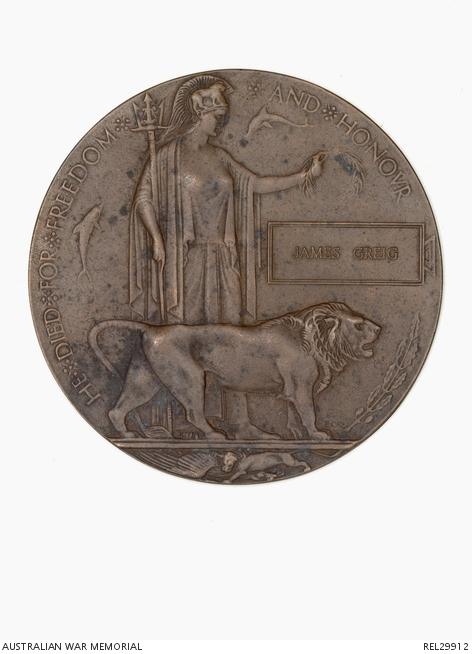1914–1918 Memorial Scroll and plaque
Memorial Scroll
In 1922 a Memorial Scroll was presented to the next of kin of those soldiers, sailors, and nurses who died while serving in the Australian Imperial Force or Royal Australian Navy during the First World War. Later they were presented with a Next of Kin Memorial Plaque.
The Memorial Scroll bears the Royal Coat of Arms and a message paying tribute to the soldiers who gave up "their own lives that others might live in freedom".
Memorial Plaque
The round bronze Memorial Plaque is 120mm in diameter. It shows Britannia and a lion on the front and bears the inscription: "He died for freedom and honour". The full name of the dead soldier is engraved on the right hand side of the plaque. No rank, unit or decorations are shown, befitting the equality of the sacrifice made by all casualties.
The shape and appearance of the plaque earned it nicknames such as the "Dead Man's Penny", the "Death Penny", and the "Widow's Penny".

Bronze plaque showing Britannia and a lion with the words 'HE DIED FOR FREEDOM AND HONOUR' around the edge. The embossed name 'JAMES GREIG' appears in a rectangle with a raised edge.
Sources
- Julie Dunne, "Dead Man's Penny: a biography of the First World War bronze memorial plaque" in Nicholas J. Saunders (ed.), "Beyond the dead horizon": studies in modern conflict archeology, Oxbow, Oxford, 2012, pp. 1—13
- Philip Dutton, "The Dead Man's Penny: a short history of the Next of Kin Memorial Plaque", The Medal 29, Autumn 1996, pp. 62–71
- Hal Giblin, "The Memorial Plaque", Medal News, April 1990, p. 20
Further Information
- 1914–1918 Memorial Plaque
- Memorial Plaques held by the Australian War Memorial
- Examples of the letters associated with the Memorial Plaque and Scroll
- Form letter which accompanied Memorial Plaque ("Dead Man's Penny")
- Commemorative letter from King George V
- Commemorative scroll
- Pink telegram informing relatives of death
- Letter of condolence from Captain
- Letter from George V to those who were wounded
- Letter from George V to those who were prisoners of war
- The Next of Kin Memorial Plaque and Scroll
The Great War 1914–1918
